
Eyes in the Sky: Advanced Technologies Transforming Earth Observation
Eyes in the Sky: Advanced Technologies Transforming Earth Observation is revolutionizing the way we monitor our planet. With the help of satellite technology and remote sensing, we can now observe the Earth in unprecedented detail, allowing us to track changes, predict trends, and make informed decisions.
The use of Eyes in the Sky: Advanced Technologies Transforming Earth Observation has numerous applications, including environmental monitoring, natural resource management, and disaster response. By analyzing data from satellites and other remote sensing platforms, scientists and policymakers can gain valuable insights into the health of our planet and make data-driven decisions to mitigate the effects of climate change, deforestation, and other pressing issues.
History of Earth Observation
The history of earth observation dates back to the 1960s, when the first satellites were launched into orbit. These early satellites were equipped with basic sensors that could detect changes in the Earth’s surface, such as cloud cover and ocean currents. Over the years, the technology has evolved significantly, with the development of more advanced sensors, higher resolution imaging, and increased computational power.
Today, earth observation involves a wide range of technologies, including satellite remote sensing, airborne remote sensing, and in-situ measurements. Satellite remote sensing involves the use of satellites in orbit around the Earth to collect data on the planet’s surface and atmosphere. Airborne remote sensing involves the use of aircraft-mounted sensors to collect data, while in-situ measurements involve the use of ground-based sensors to collect data directly.
Advanced Technologies in Earth Observation
Several advanced technologies are transforming the field of earth observation, including synthetic aperture radar (SAR), hyperspectral imaging, and cloud computing. SAR technology allows for high-resolution imaging of the Earth’s surface, even in cloudy or dark conditions. Hyperspectral imaging involves the collection of data across a wide range of wavelengths, allowing for detailed analysis of the Earth’s surface and atmosphere.
Cloud computing is also playing a major role in earth observation, enabling the processing and analysis of large datasets in a scalable and cost-effective manner. This has opened up new opportunities for researchers and policymakers to access and analyze earth observation data, and to develop new applications and services.
Applications of Earth Observation
The applications of earth observation are diverse and widespread, ranging from environmental monitoring to natural resource management. Some of the key applications include land use/land cover mapping, crop yield prediction, and disaster response. Land use/land cover mapping involves the use of satellite data to track changes in land use and land cover, such as deforestation or urbanization.
Crop yield prediction involves the use of satellite data to predict crop yields, allowing farmers and policymakers to make informed decisions about planting, harvesting, and pricing. Disaster response involves the use of satellite data to respond to natural disasters, such as hurricanes, wildfires, and floods.
Conclusion
In conclusion, Eyes in the Sky: Advanced Technologies Transforming Earth Observation is revolutionizing the way we monitor our planet. With the help of satellite technology and remote sensing, we can now observe the Earth in unprecedented detail, allowing us to track changes, predict trends, and make informed decisions. As the technology continues to evolve, we can expect to see even more innovative applications of earth observation in the future.




